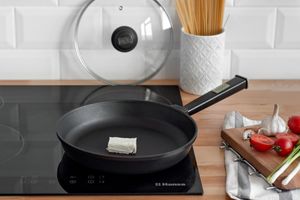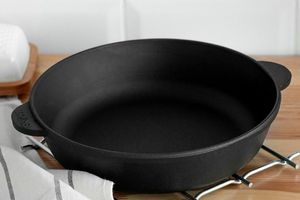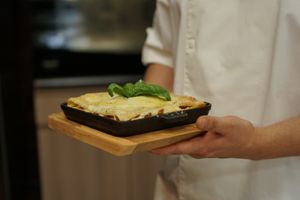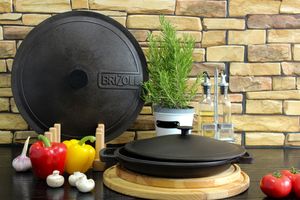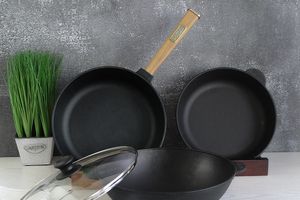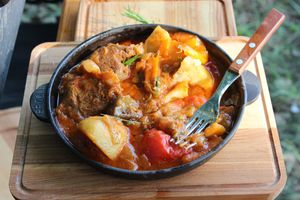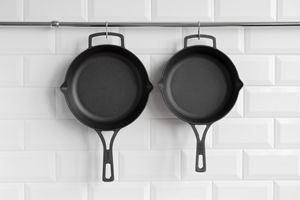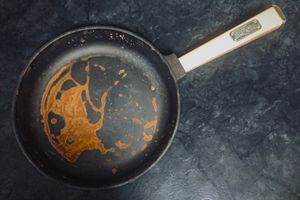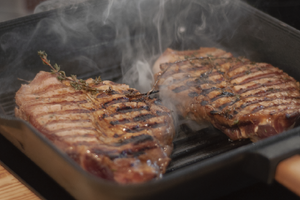Coating of TM Brizoll cast iron cookware is natural!
It is formed on the surface of the cookware during its finishing in production.
A layer of high-quality 100% natural vegetable oil is applied to the finished products and then they are baked in an oven using a special technology. This process is called polymerization. Thus a primary natural non-stick coating is formed on our cast iron cookware, which is a layer of carbonated oil. In addition to its valuable non-stick properties this layer also protects cast iron from rusting. Thanks to this feature, the cast iron cookware can be used for many decades and come down from generation to generation along with your favorite family recipes.
A layer of high-quality 100% natural vegetable oil is applied to the finished products and then they are baked in an oven using a special technology. This process is called polymerization. Thus a primary natural non-stick coating is formed on our cast iron cookware, which is a layer of carbonated oil. In addition to its valuable non-stick properties this layer also protects cast iron from rusting. Thanks to this feature, the cast iron cookware can be used for many decades and come down from generation to generation along with your favorite family recipes.
- - - - - - - - - - - - - - - - - - - - - - - - - - - - - - - - - - -
How to treat the cast iron
How to treat the cast iron
cookware properly?
- - - - - - - - - - - - - - - - - - - - - - - - - - - - - - - - - - -
In order to preserve the coating on cast iron cookware, it is just enough to cook in it with the use of oil. Coating will only get better with each cooking.
And yet there are factors that will wear out the coating. For example, cooking food that is too acidic or alkaline, using abrasive cleaning agents and tools, very high temperatures, and the like. That is why we recommend cleaning cast iron cookware with subsequent treatment with oil. This simple rule of thumb will protect your cast iron cookware and keep its natural non-stick properties.
But even if you suddenly damage the protective coating of your cast iron cookware, remember that this is not a problem at all! In this case, it just needs to be treated with oil and baked in an oven or warming drawer. The same should be done when restoring cast iron cookware when it rusts. This simple procedure will completely restore protective coating of your cast iron cookware! It is appropriate to carry out such processing several times a year.
In order to preserve the coating on cast iron cookware, it is just enough to cook in it with the use of oil. Coating will only get better with each cooking.
And yet there are factors that will wear out the coating. For example, cooking food that is too acidic or alkaline, using abrasive cleaning agents and tools, very high temperatures, and the like. That is why we recommend cleaning cast iron cookware with subsequent treatment with oil. This simple rule of thumb will protect your cast iron cookware and keep its natural non-stick properties.
But even if you suddenly damage the protective coating of your cast iron cookware, remember that this is not a problem at all! In this case, it just needs to be treated with oil and baked in an oven or warming drawer. The same should be done when restoring cast iron cookware when it rusts. This simple procedure will completely restore protective coating of your cast iron cookware! It is appropriate to carry out such processing several times a year.
Follow our step-by-step guide to restore the cover of your cast iron cookware.
-- STEP 1 --
CLEANING
Rinse the cast iron cookware with warm water using a small amount of detergent. Use a dishwashing brush or washcloth if necessary. Rinse off the detergent and dry the cookware and hands thoroughly with a towel.
CLEANING
Rinse the cast iron cookware with warm water using a small amount of detergent. Use a dishwashing brush or washcloth if necessary. Rinse off the detergent and dry the cookware and hands thoroughly with a towel.
-- STEP 2 --
SEASONING
Lightly coat the cookware with oil on the outside and inside. Do not use too much oil - this will make the cookware sticky.
SEASONING
Lightly coat the cookware with oil on the outside and inside. Do not use too much oil - this will make the cookware sticky.
-- STEP 3 --
BAKING
Place the oiled cast iron cookware in the oven upside-down on the wire shelf and bake for 1 hour at a temperature of 230-260 °C (450-500 °F). Place a baking sheet under the wire shelf and line with foil. This must be done so that the remaining oil that can drain from the cookware through the wire shelf does not stain and burn on the surface of your oven. Allow the cookware to cool down when finished.
What kind of oil can be used to treat cast iron cookware?
Any cooking oil or fat is suitable for processing cast iron cookware, but oils with a high smoke temperature (point) cope with this task better. These are, as a rule, refined vegetable oils.
What kind of oil is used in the production of TM Brizoll cast iron cookware?
During the finishing treatment of cookware at the TM Brizoll production facility a thin layer of high-quality 100% natural vegetable oil is applied to the finished products. It is highly refined, does not contain harmful impurities and has an optimal smoke rate - that is, it is ideal for the polymerization process of our cast iron cookware.
F.A.Q. on this topic.
Why does cast iron cookware have a rough surface?
Cast iron is a porous material by the structure. It is an iron alloy to which carbon was added in large quantities during the cooling process. Due to the concentration of carbon above the limiting solubility, the formed alloy is characterized by high hardness, but low homogeneity. The cast iron cookware surface is even additionally processed during the production to increase its roughness. This in turn makes it possible to increase the adhesion area of the coated cast iron and make it more durable. In the process of using your dishes, its surface will gradually be smoothed due to the thickening of the layer of its natural protective coating.
Can the coating of cast iron cookware peel off? What if this happens?
Sometimes the protective coating on cast iron cookware can peel off. It's OK. This happens when the oil layer is not baked on the cast-iron surface and came off it. All you need to do: rinse with warm water, dry well and grease with a thin layer of oil to form a more stable coating and additionally bake in the oven, as described in our step-by-step instructions.
What foods can damage the coating of cast iron cookware?
Foods that are too acidic, such as tomatoes, lemon juice or berries can damage the natural protective coating of cast iron cookware if cooked for a long time. Therefore, we advise to avoid cooking too acidic and liquid dishes until the layer of the protective coating becomes thicker at the beginning of using the TM Brizoll cast iron cookware.
Why do black smudges and stains remain on the towel after cleaning cast iron dishes?
Black smudges and stains are natural deposits that came off the surface of your cast iron cookware. This happens when it comes into contact with acidic foods or when cooking temperatures are too high. Nothing wrong with that. After the dishes are well dry, just grease them with oil and use as usual.
















